Chickenpox epidemiology and demographics: Difference between revisions
(→Gender) |
m (Bot: Removing from Primary care) |
||
| (35 intermediate revisions by 8 users not shown) | |||
| Line 1: | Line 1: | ||
__NOTOC__ | __NOTOC__ | ||
{{CMG}} {{AE}} | {{CMG}}; {{AE}} {{ARK}} | ||
{{Chickenpox}} | {{Chickenpox}} | ||
==Overview== | ==Overview== | ||
The [[incidence]] of [[chickenpox]] varies among various age groups. [[Varicella]] commonly affects children less than 10 years of age with the highest [[incidence]] among children 1-4 years of age. The [[incidence]] of [[chickenpox]] for children between 0 to 4 years of age is 5234 per 100,000 individuals. Between the years 1990-1994, the [[case fatality rate]] of [[chickenpox]] in the US/UK was 2-3 per 100,000 individuals. In developed countries, [[chickenpox]] causes around 3 deaths per 100,000 individuals. | |||
In | |||
==Epidemiology== | |||
===Incidence=== | ===Incidence=== | ||
The incidence of | The [[incidence]] of [[chickenpox]] varies among various age groups. The [[incidence]] rates per 100,000 persons in each age group were as follow: | ||
*For age groups 0 to 4 years 5234 per 100,000 | *For age groups 0 to 4 years 5234 per 100,000 individuals | ||
*For age groups 5 to 9 years 4132 per 100,000 | *For age groups 5 to 9 years 4132 per 100,000 individuals | ||
*For age groups 10 to 14 years 1404 per 100,000 | *For age groups 10 to 14 years 1404 per 100,000 individuals | ||
*For age groups 15 to 19 years 610 per 100,000 | *For age groups 15 to 19 years 610 per 100,000 individuals | ||
*For age groups >20 years 175 per 100,000 | *For age groups >20 years 175 per 100,000 individuals | ||
The rates of [[incidence]] of [[chickenpox]] declines for older age groups.<ref name="pmid7658062">{{cite journal |vauthors=Choo PW, Donahue JG, Manson JE, Platt R |title=The epidemiology of varicella and its complications |journal=J. Infect. Dis. |volume=172 |issue=3 |pages=706–12 |year=1995 |pmid=7658062 |doi= |url=}}</ref> | |||
[[Image:Chickenpox Graph 1.jpg|center|thumb|500px|Source: https://www.cdc.gov/]] | |||
===Case Fatality Rate=== | ===Case Fatality Rate=== | ||
Between the years 1990-1994, case fatality rate in the US/UK is 2-3 per 100,000. | |||
*The [[case fatality rate]] among children was 1 per 100,000. | |||
*In 2008 the [[case fatality rate]] in Brazil estimated [[case fatality rate]] is 4 per 100,000. <ref name="urlwww.who.int">{{cite web |url=http://www.who.int/immunization/sage/meetings/2014/april/2_SAGE_April_VZV_Seward_Varicella.pdf |title=www.who.int |format= |work= |accessdate=}}</ref> | |||
*In 2000 the [[case fatality rate]] in Guinea Bissau was approximately 129 per 100,000 cases, 50 times higher than US/UK. | |||
*In 1970, the [[case fatality rate]] in India among adults was 52 per 100,000 cases, 20 times higher than US/UK. | |||
*Worldwide, the [[case fatality rate]] among adults was 20-25 per 100,000. <ref name="urlwww.who.int">{{cite web |url=http://www.who.int/immunization/sage/meetings/2014/april/2_SAGE_April_VZV_Seward_Varicella.pdf |title=www.who.int |format= |work= |accessdate=}}</ref> | |||
[[Image:VZV - Case Fatality Rate.jpg|center|500px|source: WHO.int]] | |||
==Demographics== | |||
===Age=== | ===Age=== | ||
*The prevalence of chicken pox decreases with age. | *The [[prevalence]] of chicken pox decreases with age. | ||
*Varicella commonly affects children less than 10 years of age with the highest incidence among children 1-4 years of age. | *Varicella commonly affects children less than 10 years of age with the highest [[incidence]] among children 1-4 years of age. | ||
[[Image:VZV_-_Age 2.jpg|center|600px|source: WHO.int]] | |||
[[Image:Chickenpox Graph 3.jpg|center|600px|source: WHO.int]] | |||
===Gender=== | ===Gender=== | ||
*The prevalence and incidence of chickenpox | *The [[prevalence]] and [[incidence]] of chickenpox generally do not vary by gender. | ||
*Chickenpox is more prevalent in females between the ages of 15 - 24 | *Chickenpox is more prevalent in females between the ages of 15 - 24 as compared to males.<ref name="pmid14979582">{{cite journal |vauthors=Fleming DM, Cross KW, Cobb WA, Chapman RS |title=Gender difference in the incidence of shingles |journal=Epidemiol. Infect. |volume=132 |issue=1 |pages=1–5 |year=2004 |pmid=14979582 |pmc=2870070 |doi= |url=}}</ref> | ||
===Race=== | ===Race=== | ||
| Line 44: | Line 46: | ||
===Developed Countries=== | ===Developed Countries=== | ||
The epidemiology and demographics of chickenpox in | The [[epidemiology]] and [[demographics]] of chickenpox in developed countries are as follows:<ref name="urlwww.who.int">{{cite web |url=http://www.who.int/immunization/sage/meetings/2014/april/2_SAGE_April_VZV_Seward_Varicella.pdf |title=www.who.int |format= |work= |accessdate=}}</ref> | ||
*Incidence | *[[Incidence]] | ||
** | **1500 – 1600 per 100,000 persons per year | ||
* | *[[Case fatality rate|Case-fatality rate]] | ||
**3 deaths per 100,000 cases | **3 deaths per 100,000 cases | ||
==Gallery== | ==Gallery== | ||
| Line 85: | Line 69: | ||
{{Reflist|2}} | {{Reflist|2}} | ||
[[Category: | {{WikiDoc Help Menu}} | ||
[[Category: | {{WikiDoc Sources}} | ||
[[Category:Disease]] | |||
[[Category:Up-To-Date]] | |||
[[Category:Dermatology]] | |||
[[Category:Pediatrics]] | [[Category:Pediatrics]] | ||
[[Category: | [[Category:Emergency medicine]] | ||
[[Category:Infectious disease]] | [[Category:Infectious disease]] | ||
[[Category: | [[Category:Pulmonology]] | ||
Latest revision as of 20:53, 29 July 2020
Editor-In-Chief: C. Michael Gibson, M.S., M.D. [1]; Associate Editor(s)-in-Chief: Aravind Reddy Kothagadi M.B.B.S[2]
|
Chickenpox Microchapters |
|
Diagnosis |
|---|
|
Treatment |
|
Case Studies |
|
Chickenpox epidemiology and demographics On the Web |
|
American Roentgen Ray Society Images of Chickenpox epidemiology and demographics |
|
Risk calculators and risk factors for Chickenpox epidemiology and demographics |
Overview
The incidence of chickenpox varies among various age groups. Varicella commonly affects children less than 10 years of age with the highest incidence among children 1-4 years of age. The incidence of chickenpox for children between 0 to 4 years of age is 5234 per 100,000 individuals. Between the years 1990-1994, the case fatality rate of chickenpox in the US/UK was 2-3 per 100,000 individuals. In developed countries, chickenpox causes around 3 deaths per 100,000 individuals.
Epidemiology
Incidence
The incidence of chickenpox varies among various age groups. The incidence rates per 100,000 persons in each age group were as follow:
- For age groups 0 to 4 years 5234 per 100,000 individuals
- For age groups 5 to 9 years 4132 per 100,000 individuals
- For age groups 10 to 14 years 1404 per 100,000 individuals
- For age groups 15 to 19 years 610 per 100,000 individuals
- For age groups >20 years 175 per 100,000 individuals
The rates of incidence of chickenpox declines for older age groups.[1]
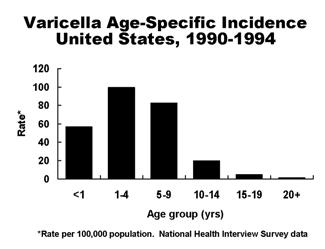
Case Fatality Rate
Between the years 1990-1994, case fatality rate in the US/UK is 2-3 per 100,000.
- The case fatality rate among children was 1 per 100,000.
- In 2008 the case fatality rate in Brazil estimated case fatality rate is 4 per 100,000. [2]
- In 2000 the case fatality rate in Guinea Bissau was approximately 129 per 100,000 cases, 50 times higher than US/UK.
- In 1970, the case fatality rate in India among adults was 52 per 100,000 cases, 20 times higher than US/UK.
- Worldwide, the case fatality rate among adults was 20-25 per 100,000. [2]
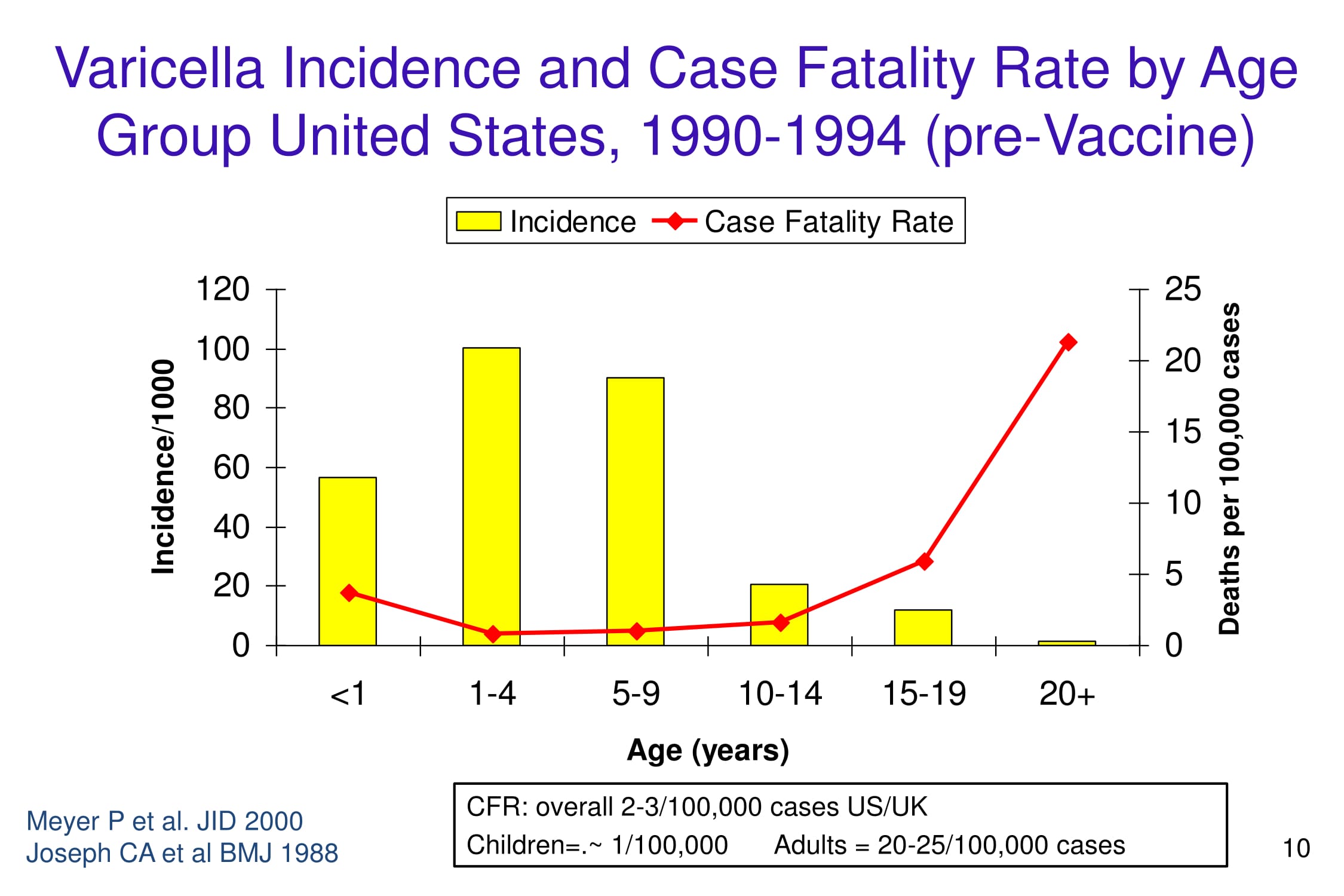
Demographics
Age
- The prevalence of chicken pox decreases with age.
- Varicella commonly affects children less than 10 years of age with the highest incidence among children 1-4 years of age.
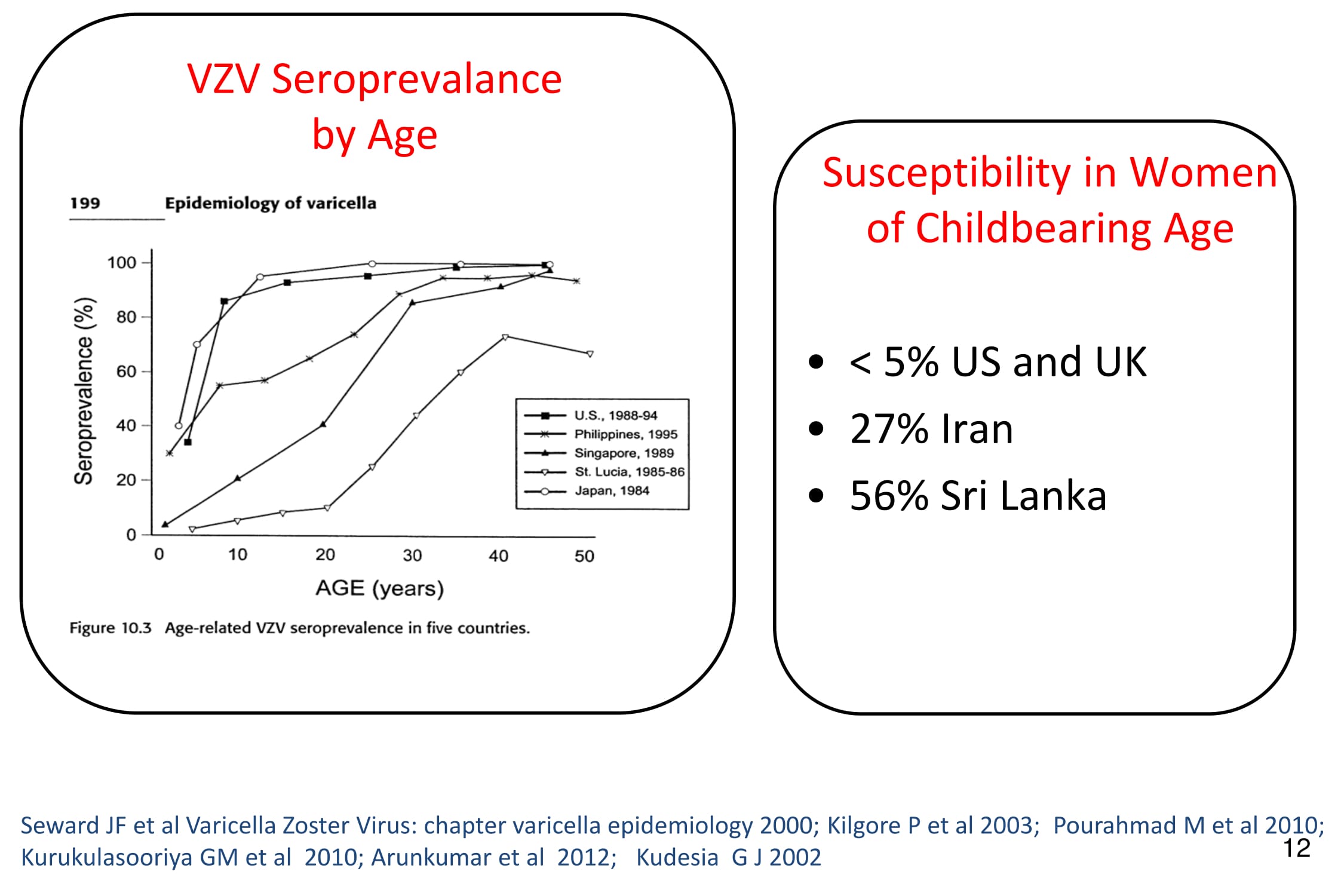
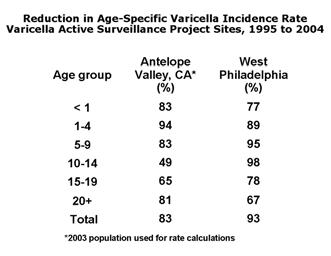
Gender
- The prevalence and incidence of chickenpox generally do not vary by gender.
- Chickenpox is more prevalent in females between the ages of 15 - 24 as compared to males.[3]
Race
- There is no racial predilection for chickenpox.
Developed Countries
The epidemiology and demographics of chickenpox in developed countries are as follows:[2]
- Incidence
- 1500 – 1600 per 100,000 persons per year
- Case-fatality rate
- 3 deaths per 100,000 cases
Gallery
-
-
-
-
-
-
Varicella cases and states reporting, United States, 1972-1996. From Public Health Image Library (PHIL). [4]
References
- ↑ Choo PW, Donahue JG, Manson JE, Platt R (1995). "The epidemiology of varicella and its complications". J. Infect. Dis. 172 (3): 706–12. PMID 7658062.
- ↑ 2.0 2.1 2.2 "www.who.int" (PDF).
- ↑ Fleming DM, Cross KW, Cobb WA, Chapman RS (2004). "Gender difference in the incidence of shingles". Epidemiol. Infect. 132 (1): 1–5. PMC 2870070. PMID 14979582.
- ↑ "Public Health Image Library (PHIL)".
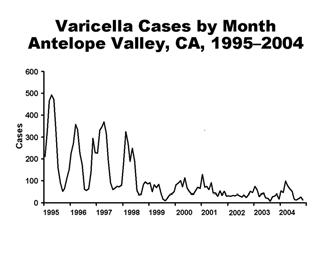
![Varicella cases and states reporting, United States, 1972-1996. From Public Health Image Library (PHIL). [4]](/images/2/26/Chickenpox40.jpeg)